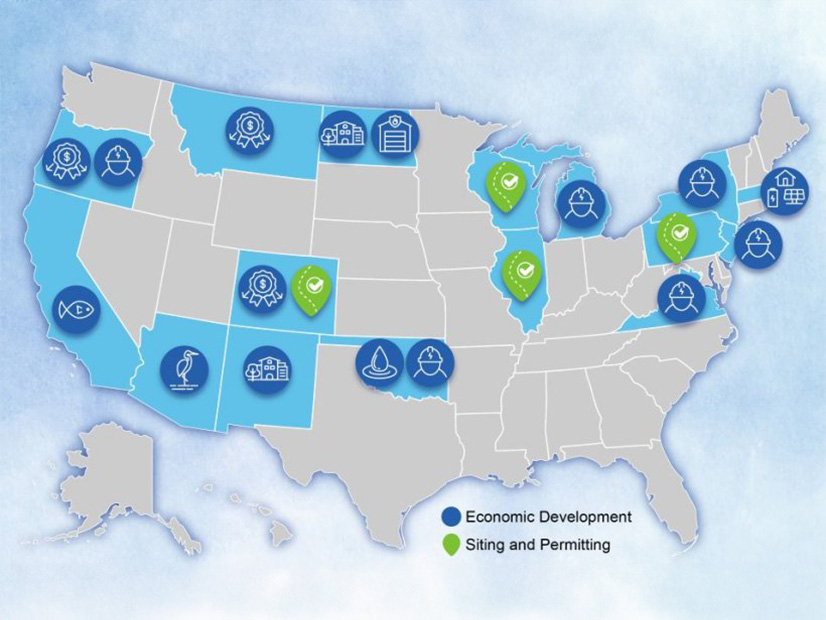
The Transmission Siting and Economic Development (TSED) grants that the U.S. Department of Energy’s Grid Deployment Office announced July 24 are not — as most of the office’s grants have been — targeted at building major new transmission projects or upgrading existing lines, said GDO Director Maria Robinson.
“This program is different,” Robinson said during an advance press call July 23. “It’s specifically designed to uplift communities impacted by transmission development, and we’re doing that by making investments that generate benefits for them beyond resilience and reliability.”
Funded by the Inflation Reduction Act, the TSED initiative will award $371 million to 20 projects in 16 states, with grants unevenly divided between two programs. Four grants totaling $17 million will go to four state and county regulatory agencies to “accelerate siting and permitting of high-voltage interstate transmission projects,” Robinson said.
The remaining $354 million is slated to go to 16 economic development projects, many in counties and towns with populations under 20,000 people, according to DOE.
So, in Baker City, Ore. (estimated population: 10,250) — near the path of the 500-kV Boardman-to-Hemingway (B2H) line — the Baker School District has been awarded $1.1 million to help establish a Lineman College and Training Hub to meet growing and future demand for utility, broadband and electric infrastructure workers. B2H will run 290 miles, connecting substations in Idaho and Oregon and delivering up to 1,000 MW of clean power in both directions, according to Idaho Power, which is building the line.
New Jersey’s Economic Development Authority will be getting $50 million, with part of the money going to coastal communities that will be affected by the development of new transmission lines for offshore wind farms. The goal is for community residents to propose, vote on and lead the development of projects that will provide local benefits.
The funds will also be used for electrical apprenticeship programs and to build bike paths along existing transmission rights-of-way, which will link to other paths to state, county and municipal parks.
“We’re very focused on making sure utilities and developers are engaging affected communities that are involved with transmission,” Robinson said. “Sometimes folks think about transmission projects as providing economic development in the short term — the construction piece, but these projects are really ensuring sustained economic development, not just during that transmission construction period. …
“This is one more piece in that overall puzzle … getting communities really invested in the idea of transmission by helping them see tangible effects through economic development.”
The grants announced July 24 represent the first round of TSED funding. The IRA provided $760 million for the program, and Robinson said a second funding announcement could be released this year. She also stressed that once the contracts are signed and funds obligated, it would be difficult for any new administration to “change direction” on the program.
Strings Attached
But the TSED grants come with significant strings attached, Robinson said. For economic development grants, the awardees will not be able to receive the funds until the transmission projects affecting their communities have actually broken ground.
For example, Idaho Power has pushed back the B2H groundbreaking a few times, so development of the Baker School District’s Lineman College and Training Hub could also be delayed.
For the siting and permitting awards, regulatory commissions and planning organizations will be able to get the money once they finalize their contracts with DOE, but they will have to commit to permitting the designated transmission lines in their states within two years.
Having that kind of hard and fast deadline could provide a challenge or new motivation for state regulators in Illinois and Wisconsin, both of which have been awarded grants to accelerate permitting on lines from the first tranche of MISO’s Long Range Transmission Planning (LRTP) portfolio, a web of 345-kV lines crossing nine states.
As originally approved in 2022, the 18 projects in Tranche 1 are expected to come online between 2028 and 2030 at an estimated cost of $10.3 billion. (See MISO Board Approves $10B in Long-range Tx Projects.)
To help the Illinois Commerce Commission (ICC) up its permitting game, the state will receive a TSED grant of $8.2 million to streamline its approval processes while also protecting of the state’s natural resources and incorporating community concerns into transmission siting and approval, according to the ICC. A major focus will be on updating customer-facing databases related to the LTRP lines in the state.
The Wisconsin Public Service Commission intends to use its $3 million grant to increase staff and resources to accelerate permitting for three LTRP projects. According to DOE’s project description, the commission will “increase its outreach and engagement with the public, improve its coordination with other siting entities and develop plain language educational materials on high-voltage transmission lines.”
The other two siting and permitting grants include:
-
- $4.5 million to the Pennsylvania Public Utility Commission to improve its siting processes for projects from PJM’s Regional Transmission Expansion Plan crossing the state. The funds will go toward “expanding [PUC’s] public and community engagement, participating in more site visits and public input hearings, and providing education and training opportunities to its staff.”
-
- $1.7 million to Alamosa County in southern Colorado (estimated population: 16,655) to conduct an extensive analysis and broad community outreach to evaluate three potential corridors for increasing transmission capacity in the region and northern New Mexico.


